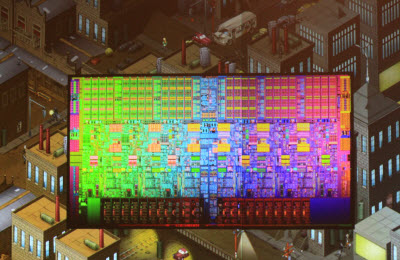
The new Intel Xeon processor 5600 series chips have as many as six cores, or computing brains in a chip. They have other features that, taken together, allow a server with just one Xeon 5600 chip to replace 15 single-core servers from five years ago. The investment in the new chip can pay off in as little as five months if it is used to replace five-year-old servers, said Boyd Davis, general manager of data center group marketing at Santa Clara, Calif.-based Intel. The new chips are also setting performance records in server benchmark tests.
[aditude-amp id="flyingcarpet" targeting='{"env":"staging","page_type":"article","post_id":168362,"post_type":"story","post_chan":"none","tags":null,"ai":false,"category":"none","all_categories":"business,","session":"A"}']These chips are arriving at the right time. Gartner estimates that about a million servers that should have been replaced have not been replaced during the recession. Intel itself estimates that about 80 percent of existing servers should be replaced because they’re wasting energy and money in comparison to the new server chips. Intel says that the cost of not replacing 50 single-core servers with three Intel Xeon 5600 servers is $10,000.
AI Weekly
The must-read newsletter for AI and Big Data industry written by Khari Johnson, Kyle Wiggers, and Seth Colaner.
Included with VentureBeat Insider and VentureBeat VIP memberships.
To give a perspective of the performance increase, Intel showed reporters a mural on a huge projection screen at an event in San Francisco. A chip, Davis noted, has so much detail on it that it looks like a giant city when viewed as in the above picture. One side of the mural depicted the Gold Rush, when chips in the good old days had very little detail on them, like a small mining town. Then chips got more complicated, resembling Industrial Revolution cities. Now they’re so crowded and futuristic, they look like cities of the future. The security has moved from a small-town Sheriff to constant monitoring via surveillance cameras.
Advanced Micro Devices has already launched its own six-core chips. AMD will launch its own new 8-core and 12-core server chips later this month. The Sunnyvale, Calif.-based rival says its upcoming Magny Cours chips will be 33 percent more memory efficient than Westmere.
Intel says its new chips will also have better built-in security. The 5600 series chips will include Intel AES-NI, a new set of instructions that will enable faster encryption and decryption of data. The frequency of the four-core version of the 5600 series tops out at 3.46 gigahertz with power usage of 130 watts, while the six-core version tops out at 3.33 gigahertz and 130 watt watts. Lower-power versions are also available.
VentureBeat's mission is to be a digital town square for technical decision-makers to gain knowledge about transformative enterprise technology and transact. Learn More
